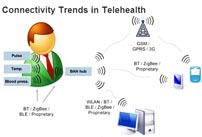According to a recent report from Kalorama Information, the telemedicine patient-monitoring market grew from $4.2 billion in 2007 to over $10 billion in 2012. In a another report, InMedica predicts the worldwide telehealth market will grow by 55% in 2013, in terms of device and service revenues. This data points to a transformation of healthcare to where a large number of patients are being empowered to use medical devices outside of the doctor's office.
Enabled by the rise in higher-performance, reliable technology, telehealth is a distributed, patient-oriented care model that heavily relies on wireless connectivity and embedded systems to power portable medical devices and provide 24/7 monitoring. However, while some marvel at the convenience of this model, it's also putting a lot of pressure on device makers to ensure they're not only meeting the appropriate certifications and guidelines, but also providing patients with a simple, yet effective tool. There are still large technological challenges with building the devices and telecommunications infrastructure to support the growth of telehealth. NOR flash memory solutions are helping to ease this burden.
Enabling the infrastructure
NOR flash memory plays a critical role in building out the telecommunications infrastructure used to support this growing market by providing consistent and secure access to code and data. Additionally, because high reliability code and data storage is required, NOR flash memory, which comes in a wide range of densities, is perfectly suited for advanced networking gear to ensure systems are up and running. Software engineers are constantly tasked with keeping up with telecommunications protocols and telecommunications companies need flexible systems that can be upgraded with newer standards. For this reason, NV memory density requirements are more than doubling year over year. NOR flash has continued to increase in density to support these requirements and is available up to 8 Gbits in a single monolithic die. These new and upgraded networks ensure that doctors get the data they need in a secure and timely manner.

Creating effective and reliable devices
Designing the embedded systems found in telehealth devices is not an easy task. It requires sophisticated software and storage capabilities with high levels of quality, security, and reliability. Flash memory solutions, specifically NOR flash because of its reliability and longevity, are able to provide the onboard storage needed to achieve the full potential of such devices. And, NOR flash provides an instant-on capability for fast boot times.
Flash memory manufacturers are adding advanced features and capabilities. One approach is to use SPI NOR to take advantage of the low pin-count, while improving memory throughput by using DDR read operation. Systems using NOR-based SPI have reached 108-MHz bus clock rates using a QuadIO (x4) interface to achieve a 54-Mbyte/s sustained read throughput while retaining compatibility with the original interface specified 25 years ago. The latest SPI NOR product releases are incorporating a DDR read operation and reaching throughputs of 80 Mbytes/s. As system-level read throughput requirements continue to increase, a number of strategies have been deployed to optimize the SPI interface for higher performance. Customers can now design with a much simpler and cost-effective interface while not giving away either performance or features. These solutions also allow manufacturers to design a single platform and simply scale flash memory capacity up or down, depending on what is needed.

Spansion NOR flash memory chips.
Furthering graphics capabilities
The electronics industry as a whole is trending toward cost reduction, and at the same time, mobile systems are trending toward better graphics and higher-end processors. This is no different for the devices doctors and patients use. The challenge is maintaining the current quality of graphics and performance while simultaneously improving other electronic components, such as the MCU, and reducing overall cost. The evolution of NOR flash density will become a key factor in cost reduction while enabling more advanced devices.
As mentioned before, lower-pin-count options are becoming the norm for portable devices and the preferred interface for many MCU/MPU designers. This is creating designs with new capabilities that allow code to quickly be accessed from the flash array and for graphics to be rendered directly into buffers on many controllers without the need for external RAM. This design can lower energy consumption of external memories while allowing an inherently reliable technology (NOR flash) to constantly stream graphics data for years of guaranteed performance. The random-access nature of NOR memory is suited for graphics applications and will only increase in capability over time.
Advertisement
Learn more about Spansion





